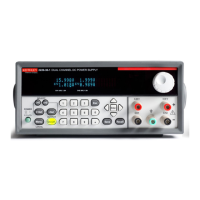Getting Started
Your power supply has a USB 2.0 high-speed device port to control the power
supply using the USBTMC protocol. The USBTMC protocol allows USB devices
to communica
te using IEEE-488.2 style messages.
If you have a G-version, you can also remotely communicate between your power
supply and PC over GPIB.
Using the USB interface
Start by connecting an appropriate USB cable between the USB 2.0 high-speed
device port on the rear panel of your power supply and a PC.
In order for the PC to recognize the power supply, a USBTMC driver must be
installed on the PC. A USBTMC driver can be installed on your PC by installing
a virtual instrument communications API like NIVISA. This VISA is available
for download from the Keithley or National Instruments Web sites. Once the
USBTMC driver is loaded, your PC will establish communication with the power
supply upon USB cable connection.
For further remote control and/or programming use, other software applications
may be needed in addition to a
VISA and the USBTMC driver.
Using the GPIB interface
Start by connecting an appropriate GPIB cable between the power supply and
either a PC or another instrument with a G PIB interface if the power supply is
in a multi-instrument system.
It is recommended that NIVISA be installed on your PC for the GPIB interface
for maximum programming flexibility.
To change GPIB address
settings
Your power supply must have a unique device address to function properly.
The default setting for the GPIB configuration is Communication Address 1.
If there is more than one GPIB instrument on the bus, you will need to change
the default setting on the power supply. To change the GPIB address settings,
do the following:
1. Push the Menu button on the instrument front-panel to access the main menu.
2. Press the up arrow key until you see User Settings andthenpresstheEnter
button.
3. Press the up or down arrow key until you see Communication Port and
then press the Enter button.
4. You can now change the address of your GPIB port.
Series 2200 Programmable Multichannel DC Power Supplies Programmer Manual 1-1

